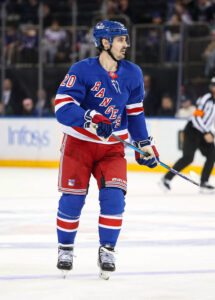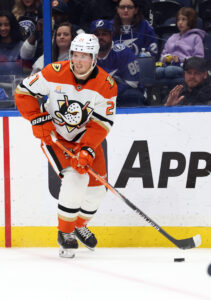When the Penguins acquired defenseman Erik Karlsson from the Sharks in August 2023, they envisioned him giving their big three (Sidney Crosby, Evgeni Malkin, and Kris Letang) one last push for a playoff run. Two and a third years into the experiment, the results haven’t been promising, as Pittsburgh missed the playoffs in back-to-back seasons and has entered into a rebuild — or at least, that’s what they believed.
However, Karlsson and the big three have the Penguins in contention for a playoff spot some 26 games into the season, in a year when they expected to be one of the worst teams in the league. Karlsson is nowhere near the offensive producer he was during the 2022-23 season when he won the Norris Trophy and registered 101 points, but he has been in good form this year and has provided Pittsburgh with more of a two-way presence on their back end.
When Pittsburgh started the season, the left side of their defense looked like a black hole because they had very little depth at that position, and it was expected to be the team’s Achilles’ heel. Fortunately for Pittsburgh, recent signee free agent Parker Wotherspoon stepped up and claimed one of the spots in the top six.
Not long after, Wotherspoon was paired with Karlsson, and together they have become Pittsburgh’s top defensive pairing. There were no expectations for Karlsson or Wotherspoon this season. Still, under the guidance of first-year head coach Dan Muse, Karlsson appears to be a completely different player, and Wotherspoon has become a meaningful NHL defenseman for the first time in his short professional career.
Using the eye test, Karlsson looks like a different player compared to the past two seasons. He is playing a more focused defensive game and has shown more defensive awareness than he has in a long time. His skating in the defensive zone has been effective in recovering to get back into position, closing gaps, and, along with his instincts, breaking up plays.
On the offensive side, Karlsson remains a fantastic playmaker, still demonstrating the elite vision that has helped him win three Norris Trophies. Even if his goal-scoring isn’t what it once was, he is still an elite offensive player who could be ready to break out.
Even if his offensive stats hover around 55 to 60 points, which is about where they are this season (one goal and 17 assists in 26 games), Karlsson’s play away from the puck makes his lower offensive totals easier to accept. In fact, Karlsson and Wotherspoon have not only formed a solid defensive pairing, but they have also been highly effective at killing penalties and are Pittsburgh’s most-used defensive duo when shorthanded. Their even-strength play has been strong as well, with Karlsson and Wotherspoon limiting high-danger scoring chances, demonstrating a defensive awareness rarely seen in Karlsson’s game.
Karlsson appears more comfortable on the ice, playing loose and fast, a stark contrast to the last few years, when the 35-year-old seemed as though Father Time had caught up with him. A perfect example is this past Monday in a game against the Flyers.
With the game tied 1-1, Karlsson collects the puck, bursts out from behind his own net, skates straight to the middle of the ice in the offensive zone and drives right at the two Flyers defenders. He then cuts to the right and makes a tape-to-tape cross-ice pass to Bryan Rust, who spots the trailer (Crosby) for a one-timer that ends up in the back of Philadelphia’s net. It’s a goal that Karlsson didn’t start a year or two ago, and it highlights the change in his work rate.
It also makes one wonder where Karlsson and the Penguins will finish this season. It might even be better if not for a significant injury bug that swept through the room at the start of November, bringing down Noel Acciari, Rickard Rakell, and Justin Brazeau, among others. The injuries effectively removed one forward from each line and put the Penguins in a position where their depth was tested in November, and quite frankly, they don’t have much depth.
You could argue that Karlsson has been lucky, and that some of his mistakes are being offset by Wotherspoon’s consistent performance and the efforts of his goalies. This idea is valid, as Karlsson and Wotherspoon have been on the ice together for 14 goals for and 10 goals against (a 58.3% goals share) while their expected goals share is just 47.3%, with projections of 15.1 goals scored and 16.8 goals conceded (all numbers via MoneyPuck). These data points do tell a story, and there might be some truth to Karlsson being fortunate, but they don’t reflect Karlsson’s own defensive contributions, which have been excellent this year compared to previous seasons.
Speaking of the Penguins’ goaltending, there is a case to be made that many of the Penguins’ shortcomings as a team have been masked by the exceptional goaltending they’ve received so far. Tristan Jarry has been excellent to start the year, with a goals saved above expected of 8.2, and Arturs Silovs has also been good with a 2.5 goals saved above expected (all numbers courtesy of MoneyPuck). That kind of goaltending can’t be expected to continue for the rest of the year, especially in Jarry’s case, who has a history of struggling in the second half of the season. But, for now, it’s a significant reason that Pittsburgh is in contention for the postseason, along with the play of Karlsson and other veterans.
A consistent feature of Pittsburgh this year has been its veteran stars, including Karlsson. He’s remained a dependable presence for the team and could step up further as the season approaches the Olympics. Karlsson is clearly driven by something, and the Olympics are as good an assumption as any.
There is also the possibility that Karlsson understands the situation he’s in. Karlsson was expected to be traded in the summer, but that never happened, which means he might be stuck in Pittsburgh until next year or until his contract expires at the end of the 2027 season. The Penguins will likely make moves next summer to speed up their rebuild—Josh Yohe of The Athletic has repeatedly expressed this belief. Looking at the mix of young prospects and veterans still playing at a high level, it all makes sense. Pittsburgh isn’t a Stanley Cup contender right now and probably won’t be for a few more years. However, with the 2025 draft selections that they made and a potential superstar goalie in Sergey Murashov, that timeline could shift very soon.
If Karlsson stays with the team next season, it could be his best opportunity to chase a Stanley Cup. Even if he doesn’t, there will be motivation to extend his career beyond the 2026-27 season, and factors like money and his choice of destination will also serve as strong motivators.
Photo by Charles LeClaire-Imagn Images

